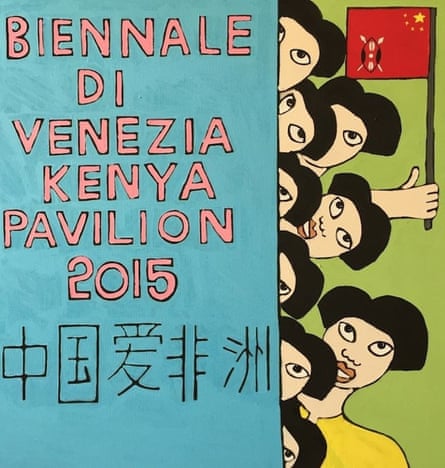Kenyan artists have expressed their frustration after it was announced that six of the eight people selected to represent the country at this year’s Venice Biennale will be Chinese.
The selection includes artists Li Gang, Shi Jinsong, and Qin Feng, who critics say have never been to Kenya and do not reference the country in their work.
For Kenyans this is depressingly familiar: at the country’s first outing at the Biennale in 2013 there was a similar controversy because only two of 12 participating artists were Kenyan-born. The entrants were selected by two Italian commissioners.
On Facebook the Nigerian curator Olabisi Silva called the choice of artists “shambolic”. She described the 2013 Kenyan pavilion, as “full of Chinese and Italian artists with some [Kenyan artists] in a dark room”, which “should not be allowed to happen again”.
A petition has been set up calling on the Venice Biennial to “renounce Kenya’s fraudulent representation”, describing the artists as “a group of well connected persons, who [have] neither the intellectual nor creative capacity to represent Kenya’s contemporary art to the international arena”.
A conference on “Kenyan misrepresentation” has also been organised, to publicly discuss why the country’s “talented and deserving artists have been systematically excluded from this event”.
Attempts by local artists and curators to meet the minister for culture, sports and the arts, Hassan Wario, to discuss the controversy proved unsuccessful, when Wario failed to attend a scheduled meeting on 20 March.
The number of Chinese migrants working in east Africa has risen sharply in recent years as infrastructure projects and investment has boomed. Some speculate that this is “imperialism 2.0” as trade has grown from $186.37m (£125m) in 2002 to $3.27bn in 2013.
But relations between Chinese workers and Kenyans has been strained: a restaurant recently caused outrage when it banned “Africans” from entering after 5pm.
In response to complaints about the selection, the Italian commissioner, Paola Poponi, emailed NPR to defend her choice by claiming it reflected the theme of the 2015 Biennale: All the World’s Futures.
She said that “talking about art from another part of the world” could be useful for Kenya in creating its own artistic identity, adding that art should not be constrained by geography. She suggested that “meeting the rest of the world” would allow Kenyan artists to analyse their own experiences “more deeply”.

But Kenyan artists aren’t convinced. Michael Soi, who documents the growing social relationship between China and Kenya in his work, responded to the selection with a painting titled The Shame in Venice 1, which depicts the ratio of Kenyan to Chinese artists in the exhibition.
“For those who don’t know,” Soi said, “Kenya has a lot of great contemporary artists who can represent Kenya. Artists living in the diaspora and the local gang operating from Nairobi and other towns in Kenya.
“The likes of Wangechi Mutu, Naomi Wanjiku Gakunga, Peterson Kamwathi, Paul Onditi, Richard Kimathi, Jimmy Ogonga, Jim Chuchu… I could go on and on. That Kenyan pavilion is as phony as a 3 dollar bill.”
Sylvia Gichia, director of the prominent Nairobi-based Kuona Trust, a residency programme bringing Kenyan artists to a global audience, said it was a “kick in the stomach”.
Many hoped that this years’ Biennale would be more inclusive. Okwui Enwezor, the Nigerian curator, is coordinating its central international exhibition, which will feature the work of 36 artists of African descent.
But with little prospect of changing the selection this year, Kenyan artists say that, yet again the Venice Biennale will not be the stage to present themselves as equals.

Comments (…)
Sign in or create your Guardian account to join the discussion